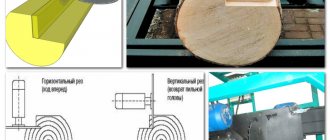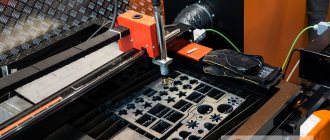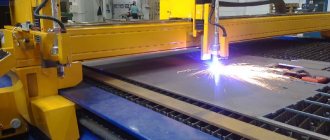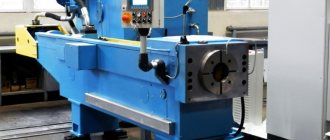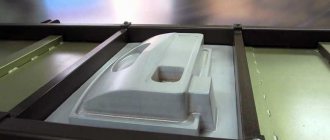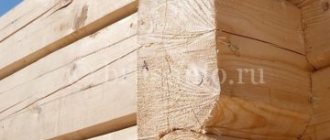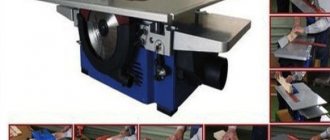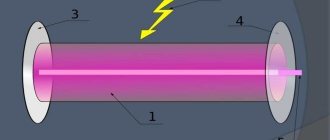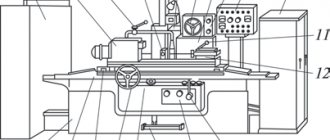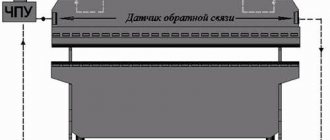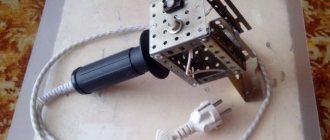Design and principle of operation
The functioning of a forging hammer is based on the dynamic impacts of the working body - the rod, connected to the head (the striking part of the machine) and devices that control the force of impact. Other required structural elements are:
- a piston connected to a woman;
- base (fixed on a solid surface);
- bed (guides for moving units are fixed on it);
- drive equipment;
- shield fence (for operator safety);
- electrical equipment;
- compressor cylinder (for pneumatic hammers).
Early machines were either foot or hand driven. A modern forging hammer is equipped with a convenient control system that minimizes the effort of the forge worker.
Rice. 1. Pneumatic hammer device.
(1 - working cylinder, 2 - compressor cylinder, 3 - piston, 4 - crank mechanism, 5 - woman, 6 and 7 - upper and lower strikers, 8 - cushion, 9 - air distribution mechanism, 10 - deformable workpiece)
Briefly, the device works like this:
- the workpiece is placed in the lower part of the hammer (usually the hammer);
- set the device to a certain impact frequency and set it in motion;
- after activating the hammer, the driven upper part hits the workpiece;
- the dynamic effect continues until the workpiece acquires the desired shape.
When a forging hammer operates, the reciprocating movement of the crank mechanism is converted into the same movement of the piston. This allows you to perform many operations on it.
Homemade hammer: super hammer
It will be easier to make a homemade blacksmith hammer for forging metal products if you divide all operations into several stages in the following sequence:
- preparing the base for installation of a forging hammer;
- designing a machine frame with springs;
- assembly of the working mechanism;
- installation of a homemade device.
Important! The design of a forging hammer largely depends on its type. It is possible to make a mechanical version at home, but constructing an electric or hydraulic hammer yourself is extremely problematic.
But before detailed instructions indicating how to make a blacksmith hammer, it should be noted the importance of creating a drawing of the future design.
Blueprints
You can make a forging hammer with your own hands in a workshop or garage. But before work, it is important to determine the current dimensions of the unit, describe all its component parts, which will subsequently make it possible to determine the weight of the product and its functionality.
To do this, you will need to draw up yourself or find on the Internet drawings and an assembly diagram of such a structure with a detailed description of all its parts.
On a note! It is easier to make mechanical-type forging hammers with your own hands, based on the classification of such units according to the nature of the force used.
Foundation
After creating the drawing, the forging devices proceed to forming the foundation. A homemade forging hammer must be installed on a flat area prepared in advance. This is necessary for the normal operation of the device and eliminating the risk of it tipping over during operation.
Electrical diagram of a forging hammer.
At the site where the structure will be installed, you need to dig a hole of the current size. Its bottom is carefully sprinkled with sand and crushed stone, watered and compacted. A reinforcing frame is mounted on top of the completed layer of sand cushion, for which reinforcement with a diameter of 12-14 mm is used.
It is extremely important not to forget about dressing, which is carried out every 250-300 mm.
The concrete solution is prepared in a ratio of 1:2:3, which will require the following materials:
- cement grade M400;
- crushed stone fraction 10-20;
- sand.
Filling should be done at a time, constantly compacting the mass. This will avoid the formation of voids inside the foundation.
At the final stage of manufacturing the base for a homemade hammer for forging into uncured concrete, it is worth installing anchor bolts, onto which the unit will subsequently be additionally fixed.
Frame
When assembling a homemade forging hammer, it requires a welding machine, with which the structure frame is assembled. It is made from profile pipes or other types of rolled metal that have high strength.
For additional stability of the product, you need to install spacers, as well as cross beams.
Hammer assembly
To begin work, you will need to assemble the frame of the unit and install it on the prepared base. The lower slides are fixed with anchor bolts and nuts, and the remaining guides and jumpers are welded to them using a welding machine.
The shaft is inserted into the racks, and then a lever with a hammer is attached to it. Drives with a pedal or lever are assembled in the same way.
A homemade forging hammer is equipped with an anvil. It performs an extremely important function, so its installation must be carried out with all responsibility. The anvil is fixed exactly under the lower position of the side, and a block of wood is placed under it.
It will act as a shock absorber when the hammer hits the anvil. The anvil is made from a piece of rail or channel, but preferably with a hardened front part. After the structure is assembled, it is painted.
Forging machine capabilities
The dimensional hammer is designed to perform the following blacksmith operations:
- bending parts (sometimes the workpiece is preheated);
- drawing (extension of the template by reducing the cross section);
- making holes (a punch/piercing is placed on the rod);
- sediment (reverse action to drawing);
- chopping (using axes).
Some of them are clear.
Rice. 2. Operations performed using a forging hammer.
Most well-known products perform all of the above operations. However, there is an important criterion for their classification.
History of the War Hammer
As mentioned above, a hammer - along with a spear and an ax - is the most ancient type of bladed weapon invented by man. When our distant ancestor realized that nature had endowed him with not very strong and long arms, and his teeth were poorly suited for self-defense, he began to arm himself. The idea of attaching a massive stone to a wooden stick is not too complicated, so it is not surprising that the war hammer dates back to the Neolithic.
Moreover, the hammer is also good for its versatility; it can be used not only as a weapon, but also to perform many household functions. Often the hammer was the butt of a stone axe, in which case the range of its use expanded even further.
After man discovered metals, hammer heads began to be made from them. First from bronze, and then from iron. Moreover, the hammer was necessary when processing metals in a forge, so it was very common. Later, already in the Middle Ages, ordinary blacksmith hammers were sometimes used in battle, mounted on longer handles.
The hammer was a traditional weapon of the ancient Germans; they used it even before the beginning of the 11th century. With the advent of plate armor, the victorious march of these weapons throughout Europe began. If up to this point a sword or spear was quite enough to defeat an enemy, then something else was needed to break through a heavily armed one. War hammers, on the other hand, had excellent “armor-piercing” characteristics, so they coped with such tasks perfectly. At the same time, they were not too difficult to use and were inexpensive. The action of a hammer is very similar to a mace, but it is more effective against heavy armor. In addition, additional elements of its warhead significantly increased the versatility of this weapon.
That is why the short hammer became a favorite weapon of infantry and cavalry. The knights for a long time disdained the despicable weapons of the townspeople, but, in the end, the harsh reality left them no choice. By the middle of the 15th century, the war hammer became the usual weapon of the horseman, for which it received its second name - “cavalry hammer”.
The infantry took a slightly different path; at the beginning of the 14th century, hammers with a shaft appeared, the length of which sometimes reached two meters, and the combat unit could include a hammer, a spear, and an ax. Sometimes the lower part of the shaft ended in a deadly spike.
Although such a weapon is usually referred to as a hammer, it is rather a hybrid of a spear, an ax and a hammer. The classification of such chimeras is a rather complicated issue, since there were a large number of their variations, and each master made weapons according to his own understanding - there was no GOST system at that time.
In Germany, such hammer-spear-axes were called fusstreithammer, in France - bec de corbin, in Switzerland - Lucerne hammers, and in England - poleaxes (poleaxes). It is the latter name that is the most popular today. Such a weapon combines the striking power of a hammer, the penetrating blow of a spear and the wide area of destruction of an ax. With its help, it was very convenient for a foot warrior to repel attacks of enemy cavalry.
Some modern historians generally believe that the polex came not from a war hammer, but from a Danish axe.
By the way, the polex was not only used in war, it was one of the most popular tournament weapons. They were often used during duels; there was even a special “duel” modification of this hammer.
Almost all examples of polaxes that have survived to this day are richly decorated and quite well made, which suggests the material wealth of their owners. Already today, studies have been carried out on the graves of soldiers who died in the battles of Visby (1361) and Tauton (1461), which showed a significant number of deaths from blows by poleaxes.
The widespread use of firearms gradually makes heavy plate armor unnecessary, and along with it the war hammer goes into oblivion. Although, of course, this does not happen immediately. In the 16th century, combined weapons appeared: swords, rapiers, and knives were placed in the handles of knives and war hammers. They are sometimes used as a firearm rest. The so-called fire stocks generally had blades that were fired from the handle. The so-called crickets were very interesting - peculiar hybrids of pistols and war hammers.
At the end of the 17th century, the war hammer almost completely lost its combat significance and turned into a fashionable attribute that emphasized the high status of its owner. It was worn by officers, and robber atamans often followed their example. This was the case in Germany and Italy. In Poland, the klewiec turned into a civilian self-defense weapon, receiving the name obushok or butt. Hammers were used for similar purposes in Belarus and Hungary.
Types of devices
This criterion is the type of substance used in the compressor cylinder. Hammers are distinguished:
Rice. 3. Mechanical forging hammer with foot drive.
- steam-air (steam or atmospheric air);
- hydraulic and hydrostatic (fluid under pressure);
- gasoline (work on the principle of internal combustion engines);
- gas (liquefied gas);
- electromagnetic (the energy of electric and magnetic fields is used);
- mechanical (powered by human physical effort);
- spring-spring (the spring accelerates the fall of the piston down);
- pneumatic (gas under pressure).
Among the listed devices, the forging pneumatic hammer stands apart. It has its own pneumatic cylinder, which eliminates the need to use additional energy sources and make the structure heavier. More details about the devices below.
Making a mechanical hammer
The most affordable design is a spring-type mechanical hammer: it is compact and can be quite productive: electric. the drive can provide up to 200...300 strokes per minute.
A homemade spring-type forging hammer with an electric drive consists of:
- Email engine that controls the rotation of the crank shaft.
- An actuator for producing oscillations.
- Springs (use automobile springs, which do not have cracks or delaminations of the metal).
- Striker with a system of guide elements.
- T-type beds.
- The chabot or bottom plate where the actual forging is done.
A forging pneumatic hammer is used for processing metal products by chopping, broaching, bending, and knocking out various holes.
Its use makes it possible to perform stamping using backing dies; working with closed dies is not recommended, since hard blows from a forging hammer may cause the headstock to be repaired.
The peculiarities of the functioning of a pneumatic forging hammer consist in the use of air, which enters the compressor of the equipment from the environment.
The incoming air, during the reciprocating action of the compressor piston, is compressed and then discharged.
The piston is driven by a drive-type electric motor using V-belts.
The working chain device also includes: a gearbox, which helps reduce the level of rotation of the crank, a crank shaft and a connecting rod.
If you pay attention to the presented drawings, you can see that the forging pneumatic hammer may not have a gearbox in the operating circuit. Pneumatic type forging equipment differs from steam-air forging equipment, in which the functioning of the falling elements is supported by steam or compressed air
A pneumatic forging installation differs from a steam-air forging equipment, in which the functioning of the falling elements is supported by steam or compressed air.
A pneumatic hammer is a device in which air serves as an elastic air cushion.
Thanks to it, the movement from the compressor piston to the worker is not transmitted rigidly.
The number of blows that a forging pneumatic hammer can perform in 60 seconds corresponds to the number of revolutions made by the crank shaft.
The forging pneumatic hammer can be equipped with falling elements with different weights, from 50 to 1000 kg. In this case, the shock wave can range from 0.8 to 28 kJ, speed from 5 to 7.5 m/s, multiplicity - 12%.
The operation of the compressor piston is carried out by a stroke with one degree of freedom, which is determined by the position of the angle of rotation of the crank shaft.
The working piston is installed in the lower position, the compressor piston is in the upper position, and the firing pin is located on the forging.
Thus, both cavities of the compressor cylinder are combined with the atmosphere with an initial pressure corresponding to atmospheric pressure.
A similar pressure is also established for the cavities of the working cylinder of a forging hammer, since they communicate through taps with the cavities of the compressor cylinder.
Having such blacksmithing equipment available, you can decorate your own home in an original way or start a profitable business.
How to assemble a pneumatic forging device, the instructions from the video material will tell you about this in more detail.
But to assemble a simple blacksmith’s hammer, you don’t need much experience. Homemade equipment can operate using a foot or electric drive.
In the latter case, the drive is connected to the electric motor using gears.
The forging hammer must stand on a flat, solid platform, which must be prepared in advance.
To do this, the working surface is filled with concrete by digging a hole in the ground measuring 2x1, with a depth of 20-30 cm.
Further instructions for assembling a homemade forging hammer provide the following stages of work:
- frame manufacturing;
- production of a working lever;
- assembling the forging hammer and installing the anvil.
Features of pneumatic hammers
The equipment refers to forging devices that perform all the previously listed operations, as well as twisting, cutting and shaping of workpieces.
They are controlled by hand lever or pedal. Structurally, the forging pneumatic hammer is complemented by an oil pump that lubricates the working cylinders (of which, by the way, there can be two). Conventionally, pneumatic hammers are divided into 2 groups:
- for artistic forging (models with a mass of falling parts up to 75 kg);
- for production (MPF - from 150 to 2000 kg).
The advantages of the equipment are energy intensity, sensitivity of adjustment of operating modes, ease of control, and durability. The disadvantage is the large size and weight, but the need for transportation rarely arises.
Selected hammer models
Today, blacksmiths use hammering machines that are a far cry from the old classic designs. Purely mechanical machines are not produced . Hydraulic hammers have pneumatic parts, and pneumatic units have hydraulic parts. Manufacturers combine different types of energy sources to save money and increase the speed of work. Let's consider individual models of hammer hammers.
Model MA-4127
For artistic forging work, a pneumatic machine MA-4127 with an impact weight of 50 kg is used. . The unit performs bending, broaching, knocking out holes, and hot cutting of parts . The machine is based on a solid cast iron frame on which the main parts are installed. The unit has a handle and a foot pedal. Equipped with a 4 kW electric motor. The stroke is 300 mm and the cylinder diameter is 225 mm. The optimal size of a square steel forging is 50 mm.
Model MA-4129
The hammer of this model is heavier , the weight of its falling part is 80 kg. Due to the rigidity of the mechanism, it is not suitable for closed dies. The hammer is launched under the influence of compressed air. The machine is equipped with an electric motor with a mechanical drive, which is a crank mechanism with a belt drive. A tractor transmission can be connected to the machine. The hollow striker is equipped with a piston ring on top and has a solid rod on the bottom. MA-4129 can operate in holding mode, in automatic, idle mode, and perform single strikes and pressing.
Model BlackSmith
The pneumatic model BlackSmith KM1-16R is used to perform various forging operations in the home workshop. The unit is reliable, easy to operate, and suitable for beginner blacksmiths . The weight of its falling part is 16 kg. Operating speed - 258 beats per minute. The striker stroke is 180 mm. The optimal forging size is 20 mm.
The mechanism of the forging hammer
At the first stage of assembling the forging hammer mechanism, a lever is made. A striker is mounted on one end of it, and a counterweight is equipped on the other.
In this case, the design of the lever can be made either in prefabricated or monolithic form. How to make a lever correctly can be considered in more detail in the proposed video material.
The use of strip steel, but not pipes, will prevent bending of the lever during strong impacts. In this case, the steel must have a thickness of at least 25 mm and a width of about 70 mm.
To do this, a pipe segment is inserted and welded into the finished hole; it will act as a bearing.
With a 70 mm wide steel strip, the hole should have a diameter such that there is 8-10 cm left to the edge of the strip, which will prevent premature repair of the installation due to deformation of the lever in this place.
Therefore, you can take a 50 mm product as a pipe for making a “bearing”.
The crossbar for the lever device is taken with a diameter that will allow it to rotate freely on the axis, but not “dangle”.
IMPORTANT TO KNOW: Operation of CNC milling machines for metal
Video:
To prevent the forge hammer lever from moving during the working process, which would require repairs at the most inopportune moment, it is additionally secured with pins.
Fastening elements are installed using radial holes.
By welding, one end of the lever is equipped with a hammer, the other with a counterweight.
The striker must be made of high-strength tool steel, otherwise such a striker will be of little use.
